
|
![]() More than any other composer, Beethoven's most popular works suffer the indignity of nicknames that he never approved. Some are mawkish and simplistic (the "Moonlight" and "Spring" Sonatas), while others seem at least moderately appropriate if superficial (the "Choral" Symphony has a chorus, the "Harp" Quartet has pizzicato passages). A few merely serve to perpetuate the name of their dedicatee (the "Waldstein" and "Kreutzer" Sonatas).
More than any other composer, Beethoven's most popular works suffer the indignity of nicknames that he never approved. Some are mawkish and simplistic (the "Moonlight" and "Spring" Sonatas), while others seem at least moderately appropriate if superficial (the "Choral" Symphony has a chorus, the "Harp" Quartet has pizzicato passages). A few merely serve to perpetuate the name of their dedicatee (the "Waldstein" and "Kreutzer" Sonatas). 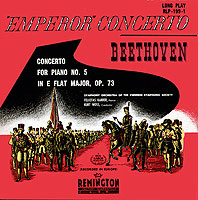
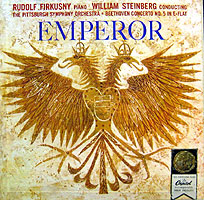 In sending his final piano concerto to his publisher, Beethoven clearly admonished: "The Concerto will be dedicated to the Archduke Rudolph and has nothing in the title but Grand Concerto dedicated to Hs. Imp. Highness the Archduke Rudolph." And yet, at least in English-speaking countries, we call it the "Emperor," a label ascribed to Johann Baptist Cramer, a London-based pianist, composer and publisher who befriended and influenced Beethoven, and who presumably attached the title for marketing purposes. (A tale is that at the Vienna premiere a French soldier cried out "C'est l'empereur!" – so much for concert decorum! Yet a tribute to Napoleon seems dubious, given that Beethoven had renunciated Bonaparte, having gone so far as to have angrily revoked his initial dedication of the "Eroica" Symphony.) Even so, some commentators find the "Emperor" tag highly appropriate. Thus Chris Nelson asserts that the music is unquestionably imperious, regal and grandiose; "with its warlike rhythms, victory motifs, thrusting melodies and affirmative character" Alfred Einstein credited it as "the apotheosis of the military concept" in Beethoven's music; and for Irving Kolodin it "conjures up imperious force, regal power, lordly disdain for small ways of thought or easy solutions of technical difficulties." George Marek, though, contends that "the proud, bold, ringing work has nothing to do with victory or defeat; it is rather an expression of the spirit � , an assertion of that belief in humanity which was so strong in Beethoven � ." Regardless, it's a convenient shorthand for "Piano Concerto # 5 in E-Flat Major, Op. 73" and so, with apologies to the composer, we'll use it here.
In sending his final piano concerto to his publisher, Beethoven clearly admonished: "The Concerto will be dedicated to the Archduke Rudolph and has nothing in the title but Grand Concerto dedicated to Hs. Imp. Highness the Archduke Rudolph." And yet, at least in English-speaking countries, we call it the "Emperor," a label ascribed to Johann Baptist Cramer, a London-based pianist, composer and publisher who befriended and influenced Beethoven, and who presumably attached the title for marketing purposes. (A tale is that at the Vienna premiere a French soldier cried out "C'est l'empereur!" – so much for concert decorum! Yet a tribute to Napoleon seems dubious, given that Beethoven had renunciated Bonaparte, having gone so far as to have angrily revoked his initial dedication of the "Eroica" Symphony.) Even so, some commentators find the "Emperor" tag highly appropriate. Thus Chris Nelson asserts that the music is unquestionably imperious, regal and grandiose; "with its warlike rhythms, victory motifs, thrusting melodies and affirmative character" Alfred Einstein credited it as "the apotheosis of the military concept" in Beethoven's music; and for Irving Kolodin it "conjures up imperious force, regal power, lordly disdain for small ways of thought or easy solutions of technical difficulties." George Marek, though, contends that "the proud, bold, ringing work has nothing to do with victory or defeat; it is rather an expression of the spirit � , an assertion of that belief in humanity which was so strong in Beethoven � ." Regardless, it's a convenient shorthand for "Piano Concerto # 5 in E-Flat Major, Op. 73" and so, with apologies to the composer, we'll use it here.
![]() The Emperor was the fifth and last of Beethoven's published piano concertos,
The Emperor was the fifth and last of Beethoven's published piano concertos,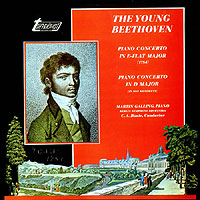 but they all were preceded by another, also in E-flat, that he had written at age 14, presumably for a performance at Bonn, where he still lived and where he was becoming known as a virtuoso. (The title page asserts that he was only 12 years old, presumably his family's attempt to exaggerate the wonder of their prodigy.) While the full score is lost, Beethoven scholar Willy Hess reconstructed the orchestration from a manuscript containing the complete solo portion and a keyboard reduction of the rest, for which Beethoven had indicated intended instrumentation for strings, flutes and horns. Heard today, it certainly sounds competent, even if firmly in the style of the time and revealing few glimmers of the colossal originality that loomed ahead. Even so, Gerald Abraham notes that the piano writing is assured for a 14-year old and sufficiently difficult to display Beethoven's burgeoning ability, in particular the concluding rondo that combines his peculiar energy and verve with wit and virtuosic brilliance. The second movement (marked larghetto – fairly slow) is especially graceful and easygoing as the piano weaves delicate filigrees around the strings and flutes. (Also intriguing is a single movement in D major; although published in 1809 by the Bohemian composer Johann Joseph Roesler as part of his own concerto, scholars now attribute it to Beethoven c. 1790 on the basis of internal and stylistic evidence. Although much of it (including the main theme) sounds like early Mozart, Antony Hodgson points out that its striking orchestral chords, held trills and downward scales in octaves foreshadow these devices in the Emperor.)
but they all were preceded by another, also in E-flat, that he had written at age 14, presumably for a performance at Bonn, where he still lived and where he was becoming known as a virtuoso. (The title page asserts that he was only 12 years old, presumably his family's attempt to exaggerate the wonder of their prodigy.) While the full score is lost, Beethoven scholar Willy Hess reconstructed the orchestration from a manuscript containing the complete solo portion and a keyboard reduction of the rest, for which Beethoven had indicated intended instrumentation for strings, flutes and horns. Heard today, it certainly sounds competent, even if firmly in the style of the time and revealing few glimmers of the colossal originality that loomed ahead. Even so, Gerald Abraham notes that the piano writing is assured for a 14-year old and sufficiently difficult to display Beethoven's burgeoning ability, in particular the concluding rondo that combines his peculiar energy and verve with wit and virtuosic brilliance. The second movement (marked larghetto – fairly slow) is especially graceful and easygoing as the piano weaves delicate filigrees around the strings and flutes. (Also intriguing is a single movement in D major; although published in 1809 by the Bohemian composer Johann Joseph Roesler as part of his own concerto, scholars now attribute it to Beethoven c. 1790 on the basis of internal and stylistic evidence. Although much of it (including the main theme) sounds like early Mozart, Antony Hodgson points out that its striking orchestral chords, held trills and downward scales in octaves foreshadow these devices in the Emperor.)
While a substantial cut above typical juvenilia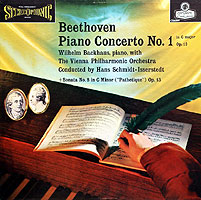 that tends to be less revered as genius than tolerated with indulgence for what was yet to come, Beethoven's first two numbered concerti remain influenced by what Lothar Hoffmann-Erbrecht ascribes to Mozart's fundamental conception that performing concertos in public was a social art of entertainment that demanded graceful, relaxed playing. In that regard, Andrew Porter notes that the writing is less adventurous, focused and expressive than in the piano sonatas that Beethoven produced at the same time. Scott Goddard considers their memorable quality of emotional expression to reside in their slow middle movements.
that tends to be less revered as genius than tolerated with indulgence for what was yet to come, Beethoven's first two numbered concerti remain influenced by what Lothar Hoffmann-Erbrecht ascribes to Mozart's fundamental conception that performing concertos in public was a social art of entertainment that demanded graceful, relaxed playing. In that regard, Andrew Porter notes that the writing is less adventurous, focused and expressive than in the piano sonatas that Beethoven produced at the same time. Scott Goddard considers their memorable quality of emotional expression to reside in their slow middle movements.
Although it was the second of his concertos to be published (and thus numbered as his # 2), Beethoven wrote his first concerto, in B-flat Major, Op. 19, for a 1795 performance. Even though he revised it for a subsequent 1798 concert in Prague,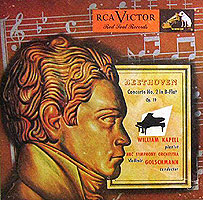 he conceded it was "not one of my best" and sold it to his publisher in 1801 for a pittance of 10 ducats; for comparison, a single box at his 1803 concert was priced at 12 ducats. Interestingly, in sending it Beethoven noted that only then was he writing out the solo part, thus suggesting that before then he had played it from memory, or perhaps even improvised the solos.
he conceded it was "not one of my best" and sold it to his publisher in 1801 for a pittance of 10 ducats; for comparison, a single box at his 1803 concert was priced at 12 ducats. Interestingly, in sending it Beethoven noted that only then was he writing out the solo part, thus suggesting that before then he had played it from memory, or perhaps even improvised the solos.
Beethoven wrote his so-called first concerto, in C Major, Op. 15, for the same 1798 Prague concert. Characterizing the earlier work in B-flat as charming and attractive yet more of a skillful appendage to a past era, Ray Minshall hails the C Major's more symphonic approach to the concerto form in light of the orchestra's expansion to include clarinets, trumpets and timpani and its increased importance of assuming an active and constructive role in developing the musical lines of thought, rather than functioning as a mere outer framework and accompaniment to the soloist. Beethoven appears to have recognized its continuing worth, writing three cadenzas for the first movement over a course of five years.
The 1802 Piano Concerto # 3, in C minor, op. 37, finds Beethoven on the cusp of his "middle period" in which his unique personal vision emerged, prodded by the demons of his encroaching deafness. Fred Grunfeld considers it a self-portrait, the acclaim of his virtuoso platform personality challenged by surging power that the pianos of his time could not fully contain. 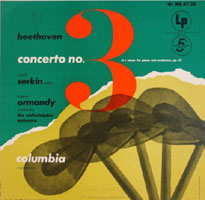 Hardly dark or somber, it emerges as serious and private – Hoffman-Erbrecht calls it confessional, fiery and pugnaciously defiant: "With furious vehemence, Beethoven places himself at the heart of the musical action, � its structure ruled by pathos, passion and violent contrasts." Its atmosphere of probing spirituality is announced at the very outset by the initial theme, softly stated by the strings as if on tip-toes, and by its prevailing minor tonality (although, rather ironically, here the slow movement suddenly brightens in distant B Major, a sudden shift to be repeated in the Emperor). In contrast to Mozart's two darker minor-key concertos (# 20 in D minor, K. 466 and # 24 in C minor, K. 491), to which Beethoven's Third often is compared, Beethoven seems more willing to give freer range to his emotions rather than sublimate them within established classical strictures.
Hardly dark or somber, it emerges as serious and private – Hoffman-Erbrecht calls it confessional, fiery and pugnaciously defiant: "With furious vehemence, Beethoven places himself at the heart of the musical action, � its structure ruled by pathos, passion and violent contrasts." Its atmosphere of probing spirituality is announced at the very outset by the initial theme, softly stated by the strings as if on tip-toes, and by its prevailing minor tonality (although, rather ironically, here the slow movement suddenly brightens in distant B Major, a sudden shift to be repeated in the Emperor). In contrast to Mozart's two darker minor-key concertos (# 20 in D minor, K. 466 and # 24 in C minor, K. 491), to which Beethoven's Third often is compared, Beethoven seems more willing to give freer range to his emotions rather than sublimate them within established classical strictures.
With his innovative 1806 Piano Concerto # 4, in G Major, op. 58, Beethoven's mood became one of introspection and overall intimacy, no longer constrained by structural expectations. This is apparent at the very outset, in which the first sound is the piano suggesting the furtive initial theme, launching an overall aura of ruminative self-reflection paced by the soloist. (Mozart already had broken tradition and paved the way by beginning his Concerto # 9, K. 271 (actually commissioned by a French harpsichordist, and heard to advantage on that instrument), with the soloist trading phrases with the orchestra.) The apex is the astounding middle movement, marked Andante con moto (slowly but with motion), often described as a dialog but more a psychological conquest in which,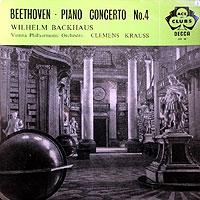 with alternating phrases, the piano lovingly calms the strings' gruff theme into submission; reduces them further to unadorned accompaniment; has a solo turn of exquisite beauty, as though seemingly satisfied with its dominance; and briefly rears in triumph, leaving the strings to muster mere fragments of their former theme and with only enough strength to lead directly into the concluding rondo. In true Romantic fashion, Liszt sought a literary analogue, comparing the Andante to Orpheus taming the wild Furies with his music, but Beethoven's approach is far subtler; as Goddard submits, its implications are so much deeper, and its poetic content so much more powerful, than any narrative tale can convey. Irving Kolodin agrees: "In whichever framework it is put, it stands as a monumental example of music's ability to say eloquently what cannot be said in any other mode of communication."
with alternating phrases, the piano lovingly calms the strings' gruff theme into submission; reduces them further to unadorned accompaniment; has a solo turn of exquisite beauty, as though seemingly satisfied with its dominance; and briefly rears in triumph, leaving the strings to muster mere fragments of their former theme and with only enough strength to lead directly into the concluding rondo. In true Romantic fashion, Liszt sought a literary analogue, comparing the Andante to Orpheus taming the wild Furies with his music, but Beethoven's approach is far subtler; as Goddard submits, its implications are so much deeper, and its poetic content so much more powerful, than any narrative tale can convey. Irving Kolodin agrees: "In whichever framework it is put, it stands as a monumental example of music's ability to say eloquently what cannot be said in any other mode of communication."
While mentioning all of Beethoven's other piano concertos before tackling the Emperor, we should also note that in late 1814 to early 1815 he sketched 70 pages of the first movement of what would have been his # 6 and began writing out the full score through the middle of the solo exposition. Nicholas Cook aptly describes the torso as largely retrospective in style yet symphonic in its materials insofar as the piano is largely relegated to a decorative role. It begins by recalling the Emperor as the piano interrupts the orchestral opening with cadenza-like scalar runs and trills but the remainder lacks distinctive themes or much other sense of character (although, to be fair, Beethoven routinely developed and reworked his scores extensively, and the final product here surely would have borne scant resemblance to these initial thoughts). Cook speculates as to why Beethoven abandoned the effort – cancellation of an 1815 benefit concert for which it might have been intended, or capitulation to his deafness that had become so profound as to preclude him from presenting the solo part, or recognition that his creative outlook was no longer suited to concertos – to which we might add a mere loss of inspiration, to which he certainly was entitled, or perhaps simply having arrived at a point where he had nothing further to say in a genre that his Emperor and Violin Concertos had raised to ultimate heights that few composers would approach, and none surpass.
![]() Beethoven began sketching the Emperor in early 1809 while Vienna was under siege and occupation by the French.
Beethoven began sketching the Emperor in early 1809 while Vienna was under siege and occupation by the French. 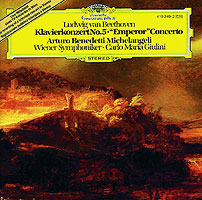 He suffered and protested the privations and was so terrified by the bombardment that he hid for a while in his brother's basement. He wrote: "The whole course of events has affected my body and soul. What a disturbing, wild life around me; nothing but drums, cannons, men, misery of all sorts." Charles Burr marvels at the circumstances under which it arose and deems it a victory of creative thought over distraction: "It is hard to believe that this masterly, ordered, architecturally triumphant composition could have been born in the middle of chaos." The score was sent to Beethoven's publisher in August 1810 and issued in February 1811; Andrew Porter notes that in the interim Beethoven took unaccustomed care poring over the proofs, suggesting the extraordinary importance he attached to it. Tellingly, unlike all his prior concertos, it was published before any performance, further suggesting that Beethoven's vision now extended beyond practicality (and reflecting his concession that his deafness precluded playing it himself). All his prior concertos had been motivated by an immediate need for a concert, but here there was no need for the extreme caution that he otherwise would have taken to maintain suspense and avoid advance exposure (and possibly plagiarism). (Ignaz von Seyfried, who sat by Beethoven to turn the pages during the premiere of the Concerto # 3, recalled that the sheets of the solo part were mostly blank or had "a few completely incomprehensible Egyptian heiroglyphics to help his memory.
He suffered and protested the privations and was so terrified by the bombardment that he hid for a while in his brother's basement. He wrote: "The whole course of events has affected my body and soul. What a disturbing, wild life around me; nothing but drums, cannons, men, misery of all sorts." Charles Burr marvels at the circumstances under which it arose and deems it a victory of creative thought over distraction: "It is hard to believe that this masterly, ordered, architecturally triumphant composition could have been born in the middle of chaos." The score was sent to Beethoven's publisher in August 1810 and issued in February 1811; Andrew Porter notes that in the interim Beethoven took unaccustomed care poring over the proofs, suggesting the extraordinary importance he attached to it. Tellingly, unlike all his prior concertos, it was published before any performance, further suggesting that Beethoven's vision now extended beyond practicality (and reflecting his concession that his deafness precluded playing it himself). All his prior concertos had been motivated by an immediate need for a concert, but here there was no need for the extreme caution that he otherwise would have taken to maintain suspense and avoid advance exposure (and possibly plagiarism). (Ignaz von Seyfried, who sat by Beethoven to turn the pages during the premiere of the Concerto # 3, recalled that the sheets of the solo part were mostly blank or had "a few completely incomprehensible Egyptian heiroglyphics to help his memory. 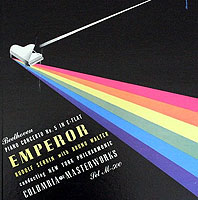 � He would throw me an apologetic glance every time he reached the end of these, to me, invisible passages and my barely concealed anxiety not to miss the decisive moment amused him visibly.")
� He would throw me an apologetic glance every time he reached the end of these, to me, invisible passages and my barely concealed anxiety not to miss the decisive moment amused him visibly.")
Kolodin views the Emperor as applying to pianists the 19th century concept of liberty, fraternity and equality, insofar as the soloist squarely confronts the orchestra as an equivalent and full partner. In that light, it can be seen as the terminus of the classical model of the concerto in which the piano was subservient to the supremacy of the orchestra. (But, as with most esthetic trends, not entirely – of those concertos that would follow, both of Chopin's [rather ironic in light of his especial devotion to the piano] and the Dvorak, Brahms 1, Busoni and Ravel for the left hand all revert to the earlier model of beginning with a full orchestral statement before the piano ventures in.) David Hall asserts that after the Emperor composers were faced with the choice of writing a brilliant display piece (Weber, Mendelssohn, Chopin, Grieg, Tchaikovsky, Rachmaninoff) or a symphony for orchestra with obbligato (essential) piano (Liszt, Brahms, d'Indy). (Hall considers only Schumann to have achieved a true balance between piano and orchestra.) In any event, many commentators consider it a model for all subsequent concertos and a towering influence by which they all must be appraised.
Rather than attempt a play-by-play account of the Emperor or an esoteric analysis of its musical innards – there are plenty of sources for that, if you're interested (I'm not!) – it seems apt to focus on the remarkable beginnings and endings of its movements.
![]() The traditional concerto model, as perfected by Mozart, invariably begins with a tutti (= all) section in which the full orchestra presents the themes and concludes with a full cadence in the original key; only then does the soloist enter with its own exposition, often launched with a brilliant flourish and possibly including additional subjects.
The traditional concerto model, as perfected by Mozart, invariably begins with a tutti (= all) section in which the full orchestra presents the themes and concludes with a full cadence in the original key; only then does the soloist enter with its own exposition, often launched with a brilliant flourish and possibly including additional subjects.
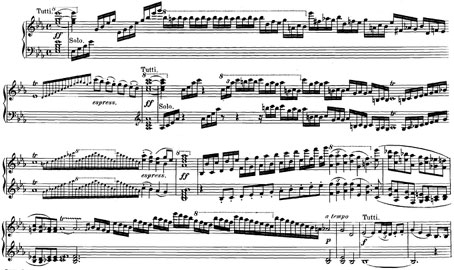 The remarkable opening (piano reduction) – the three orchestral chords and solo flights, leading to the theme |
The end of the first movement is just as novel. In traditional concerto form, the final orchestral tutti would pause on a dominant 6-4 chord to signal the pianist to launch a cadenza, an improvisation mixing allusions to the primary themes, wide modulations and seeming impulse, in which the soloist has relatively free reign to display his or her special proclivities and talents, after which a tonic trill would lead to a brief final orchestral peroration. Although Beethoven is presumed to have improvised brilliant cadenzas when performing his own concertos, he wrote out suggested ones for publication (and barely tolerated others' efforts, specifying in his Fourth: "La Cadenza sia corta" ["The cadenza is to be short."]). Here, at the critical juncture, his score specifies: "Non si fa una Cadenza, ma s'attaco subito il seguento" ("Do not make a cadenza here but attack the following immediately"). Even though the piano teasingly begins by suggesting a grand cadenza with typical introductory devices of an assertive rhythm and a massive chromatic scale, it is not to be – the horns soon join in, followed by the strings and winds, to recapitulate the major themes, as the soloist comments and augments, leading to a final, affirmative climax.
 The transition to the rondo (piano reduction) |
![]() The second movement of the Emperor, in the far distant key of B Major, shares with the opening E-flat Allegro a departure from conventional structure for a concerto movement, here comprising a sustained orchestral hymn around which the piano weaves fragile figures in sixteenth and triplet eighth notes (often simultaneously – no mean feat to play accurately!). (Note that some sources give the tempo marking as moto rather than mosso but the meaning is about the same – a bit quicker than slow.) Like the daring respite of the middle movement of the Fourth, it leads directly into the final rondo. But while the Andante of the Fourth comes to a satisfying conclusion before smoothly gliding into the soft opening of its finale, the transition of the Emperor probes deeper. David Cairns provides a compelling description: "The magical sounds gradually die away into silence and the music comes to rest on a low B. There is a sudden change of colour and the B turns into B flat. The piano tries out, softly to itself, a new theme on an arpeggio of E-flat in a rhythm that seems to be forming itself in the void left by the Adagio, while the strings listen in puzzlement, pluck a helpful chord or two.
The second movement of the Emperor, in the far distant key of B Major, shares with the opening E-flat Allegro a departure from conventional structure for a concerto movement, here comprising a sustained orchestral hymn around which the piano weaves fragile figures in sixteenth and triplet eighth notes (often simultaneously – no mean feat to play accurately!). (Note that some sources give the tempo marking as moto rather than mosso but the meaning is about the same – a bit quicker than slow.) Like the daring respite of the middle movement of the Fourth, it leads directly into the final rondo. But while the Andante of the Fourth comes to a satisfying conclusion before smoothly gliding into the soft opening of its finale, the transition of the Emperor probes deeper. David Cairns provides a compelling description: "The magical sounds gradually die away into silence and the music comes to rest on a low B. There is a sudden change of colour and the B turns into B flat. The piano tries out, softly to itself, a new theme on an arpeggio of E-flat in a rhythm that seems to be forming itself in the void left by the Adagio, while the strings listen in puzzlement, pluck a helpful chord or two.
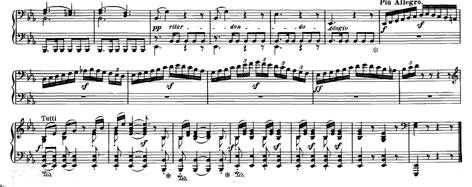 The dramatic ending (piano reduction – timpani shown in lower clef of first staff) |
![]() As Matthews observes, while the rondo finale displays a subtle balance between piano and orchestra, it abounds in dynamic contrasts that, together with the catchy rhythm inherent in the rondo format, inform the ending. As the orchestra states what appears to be the final account of the vivacious theme, the piano takes over with a commanding run that anticipates a cadenza but, as Jan Swafford notes, here, too, there is no need for one, as the piano already has been showing off throughout the rondo in a quasi-improvisatory fashion. Rather, allied with the timpani, the piano mockingly repeats the last phrase while draining the theme of interest by flattening its melody to a single repeated note and slowing its distinctive rhythm to a crawl. Having spoiled the orchestra's mood, the piano then plunges ahead with a triumphant final run of sixteenths and triplet eighths in potent octaves, allowing the orchestra to state the theme just once more and end in a full cadence, while the piano, having had its say, remains smugly silent. Warrack casts this episode as dramatizing the conflict between individual and society – the orchestral drums seemingly bring the piano to its knees, but it musters a final flourish to violently overthrow the oppression with its huge flurry of scales.
As Matthews observes, while the rondo finale displays a subtle balance between piano and orchestra, it abounds in dynamic contrasts that, together with the catchy rhythm inherent in the rondo format, inform the ending. As the orchestra states what appears to be the final account of the vivacious theme, the piano takes over with a commanding run that anticipates a cadenza but, as Jan Swafford notes, here, too, there is no need for one, as the piano already has been showing off throughout the rondo in a quasi-improvisatory fashion. Rather, allied with the timpani, the piano mockingly repeats the last phrase while draining the theme of interest by flattening its melody to a single repeated note and slowing its distinctive rhythm to a crawl. Having spoiled the orchestra's mood, the piano then plunges ahead with a triumphant final run of sixteenths and triplet eighths in potent octaves, allowing the orchestra to state the theme just once more and end in a full cadence, while the piano, having had its say, remains smugly silent. Warrack casts this episode as dramatizing the conflict between individual and society – the orchestral drums seemingly bring the piano to its knees, but it musters a final flourish to violently overthrow the oppression with its huge flurry of scales. 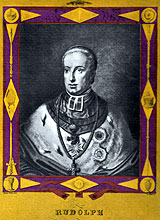 Beethoven had already used the combination of keyboard and timpani to produce a textural effect in the cadenza of his 1807 piano adaptation of his Violin Concerto, but here the impression is far more emotionally-charged and serves as a final reminder of how Beethoven seized upon the essence of the concerto genre (the contrast between solo and orchestra) to imbue it with humanistic resonance.
Beethoven had already used the combination of keyboard and timpani to produce a textural effect in the cadenza of his 1807 piano adaptation of his Violin Concerto, but here the impression is far more emotionally-charged and serves as a final reminder of how Beethoven seized upon the essence of the concerto genre (the contrast between solo and orchestra) to imbue it with humanistic resonance.
![]() Beethoven's dedication of the Emperor to Archduke Rudolph of Austria went beyond the usual significance of thanking (or soliciting) a patron among the nobility. In late 1808 Beethoven was on the verge of accepting an offer to become music director at the court of King Jerome Bonaparte of Westphalia (Napoleon's brother), which promised stability, financial security and a respite from the wartime pressures of Vienna. To avoid the disgrace of losing a national treasure, Princes Kinsky and Lobkovitz and Archduke Rudolf countered with a contract guaranteeing a fixed annual annuity in exchange for the composer's commitment to permanently reside in Austria. Beethoven accepted their offer on March 1, 1809. But soon currency was devalued, Kinsky died, Lobkovitz fell into debt and only Rudolph upheld what remained of his portion of the bargain. Of the three, Rudolph was not only a patron but a talented student, to whom, in gratitude, Beethoven dedicated not only the Emperor but numerous other masterworks – the Fourth Piano Concerto, the "Les Adieux," "Hammerklavier" and Op 111 piano sonatas, the "Archduke" Trio and the Missa Solemnis. (Anton Schindler claimed that although in later years Beethoven became quite abusive toward Rudolph with a vile temper and stormy moods, Rudolph's esteem and devotion remained unimpaired.)
Beethoven's dedication of the Emperor to Archduke Rudolph of Austria went beyond the usual significance of thanking (or soliciting) a patron among the nobility. In late 1808 Beethoven was on the verge of accepting an offer to become music director at the court of King Jerome Bonaparte of Westphalia (Napoleon's brother), which promised stability, financial security and a respite from the wartime pressures of Vienna. To avoid the disgrace of losing a national treasure, Princes Kinsky and Lobkovitz and Archduke Rudolf countered with a contract guaranteeing a fixed annual annuity in exchange for the composer's commitment to permanently reside in Austria. Beethoven accepted their offer on March 1, 1809. But soon currency was devalued, Kinsky died, Lobkovitz fell into debt and only Rudolph upheld what remained of his portion of the bargain. Of the three, Rudolph was not only a patron but a talented student, to whom, in gratitude, Beethoven dedicated not only the Emperor but numerous other masterworks – the Fourth Piano Concerto, the "Les Adieux," "Hammerklavier" and Op 111 piano sonatas, the "Archduke" Trio and the Missa Solemnis. (Anton Schindler claimed that although in later years Beethoven became quite abusive toward Rudolph with a vile temper and stormy moods, Rudolph's esteem and devotion remained unimpaired.)
![]() It's a shameful comment on the persistent gap between esthetic value and public perception that the vast bulk of Beethoven's output which we now revere as timeless masterworks often were outright failures at first, and were largely ignored during his lifetime.
It's a shameful comment on the persistent gap between esthetic value and public perception that the vast bulk of Beethoven's output which we now revere as timeless masterworks often were outright failures at first, and were largely ignored during his lifetime.
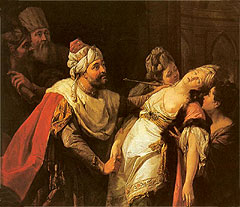 Esther Fainting Before King Ahasuerus (Marcello Bacciarelli, c. 1776) |
Alas, the more important Vienna premiere that followed on February 12, 1812 seemed doomed to fizzle. The bizarre event, presented by The Society of Noble Ladies for Charity, was more a peep show than a concert. The eagerly anticipated highlights apparently were three tableaux vivantes; Beethoven's concerto (this time played by his prot�g� Carl Czerny) came right before "Esther Fainting Before King Ahasuerus," with which, under the circumstances, it hardly could have competed. Understandably, a review complained of its "immense length" that robbed it of impact. Reported a witness: "The pictures offered a glorious treat. A new piano concerto by Beethoven failed." Ignaz Franz Castelli, an Austrian dramatist and journalist, aptly apportioned the blame: "Beethoven, full of proud confidence in himself, never works for the multitude. He demands understanding and feeling, and because of the intentional difficulties, he can receive these only at the hands of the knowing, a majority of whom is not to be found on such occasions."

![]() Any attempt to assess recordings of the Emperor Concerto
Any attempt to assess recordings of the Emperor Concerto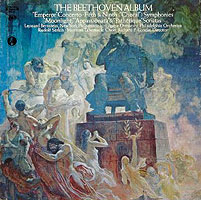 (or of any vintage work, for that matter) first must confront a fundamental question: the legitimacy of modern (or intervening) standards, as opposed to the composer's original intentions, whatever they might be. There certainly is nothing wrong with performing music of the past according to our evolving values and taste, so long as the original is preserved as a basis for later generations to analyze and adapt without the need to rely upon interim standards. (Even beyond injecting personal interpretation and exploiting the power of modern instruments, each person surely is entitled to enjoy the classics on one's own level, even if it entails Bach on a Moog synthesizer, a disco version of the Beethoven Fifth, a power rock adaptation of Mussorgsky's Pictures at an Exhibition, or even the Holst Planets through an overlay of outer-space sci-fi electronica. And who knows? – even the most severe corruptions ultimately might lead to genuine love of the real thing.)
(or of any vintage work, for that matter) first must confront a fundamental question: the legitimacy of modern (or intervening) standards, as opposed to the composer's original intentions, whatever they might be. There certainly is nothing wrong with performing music of the past according to our evolving values and taste, so long as the original is preserved as a basis for later generations to analyze and adapt without the need to rely upon interim standards. (Even beyond injecting personal interpretation and exploiting the power of modern instruments, each person surely is entitled to enjoy the classics on one's own level, even if it entails Bach on a Moog synthesizer, a disco version of the Beethoven Fifth, a power rock adaptation of Mussorgsky's Pictures at an Exhibition, or even the Holst Planets through an overlay of outer-space sci-fi electronica. And who knows? – even the most severe corruptions ultimately might lead to genuine love of the real thing.)
Nearly every serious musician seeks to discover and strives to convey composers' intentions, and so scholars exhaustively research how composers wanted their work to sound. 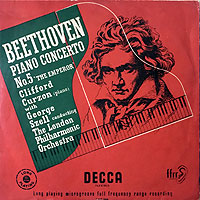 For those active before the documentation of audio recordings, we necessarily must rely upon contemporaneous written accounts that tend to be imprecise and often are prone to partisanship and exaggeration. For Beethoven, their reliability is further compromised, as recollections of his own playing differ so radically as to paint irreconcilable portraits. Indeed, even accounts by the same person can seem contradictory. Thus Beethoven's pupil Carl Czerny, to whom he entrusted the Vienna premiere of the Emperor, reported both that "Beethoven's performance of slow and sustained passages produced an almost magical effect upon every listener and so far as I know was never surpassed" and yet that Beethoven demanded too much from the pianos of his time, constantly breaking strings and hammers from the force of his playing. Czerny further credited Beethoven with the speed of his scales, double trills and leaping intervals; at the same time, Beethoven's use of the sustaining pedal was said to have brought new expressiveness to piano playing and Czerny noted that his use of the pedal was far greater than was indicated on his scores. Another pupil, Ferdinand Ries, characterized Beethoven's playing as "capricious" even while crediting him with keeping accurate time. Moreover, Beethoven was said to prefer the lighter Viennese instruments even though he belittled them as "harps," disparaged Mozart's playing as choppy and urged manufacturers to build more rugged, sonorous products.
For those active before the documentation of audio recordings, we necessarily must rely upon contemporaneous written accounts that tend to be imprecise and often are prone to partisanship and exaggeration. For Beethoven, their reliability is further compromised, as recollections of his own playing differ so radically as to paint irreconcilable portraits. Indeed, even accounts by the same person can seem contradictory. Thus Beethoven's pupil Carl Czerny, to whom he entrusted the Vienna premiere of the Emperor, reported both that "Beethoven's performance of slow and sustained passages produced an almost magical effect upon every listener and so far as I know was never surpassed" and yet that Beethoven demanded too much from the pianos of his time, constantly breaking strings and hammers from the force of his playing. Czerny further credited Beethoven with the speed of his scales, double trills and leaping intervals; at the same time, Beethoven's use of the sustaining pedal was said to have brought new expressiveness to piano playing and Czerny noted that his use of the pedal was far greater than was indicated on his scores. Another pupil, Ferdinand Ries, characterized Beethoven's playing as "capricious" even while crediting him with keeping accurate time. Moreover, Beethoven was said to prefer the lighter Viennese instruments even though he belittled them as "harps," disparaged Mozart's playing as choppy and urged manufacturers to build more rugged, sonorous products.
These seemingly conflicting views can best be reconciled by considering the weight of evidence to lean toward a highly subjective approach.  Thus a 1796 critic already slammed Beethoven for "entirely neglecting melody, evenness � delicacy and clarity, overburdening and exaggerating everything." Anton Schindler, Beethoven's first biographer (but whose propensity for self-serving fabrication draws much of his "facts" into question), reported that his master's playing "with few exceptions was always free of all constraints in matters of tempo." Josef Gelinek, a rival pianist, protested that Beethoven "has the very devil in him. � He conjures up difficulties and effects in the keyboard which we'd never even dreamed of." And while Beethoven's scores abound with precise dynamic and accent specifications, he was universally acclaimed for his brilliant improvisations and Czerny cautioned that Beethoven's playing was impulsive, "depending on his constantly changing frame of mind." Perhaps the safest conclusion to be drawn from all this is that Beethoven poured himself into his playing at both ends of the emotional scale. Harold Schonberg notes with irony that a modern pianist who tried playing like Beethoven "would be laughed off the stage as an incompetent, a stylistic idiot who knew nothing about the Beethoven style. � We would consider [Beethoven's] performances sheer anarchism if he returned today, while he would listen to current Beethoven specialists and consider them dry, unmusical and anything but expressive."
Thus a 1796 critic already slammed Beethoven for "entirely neglecting melody, evenness � delicacy and clarity, overburdening and exaggerating everything." Anton Schindler, Beethoven's first biographer (but whose propensity for self-serving fabrication draws much of his "facts" into question), reported that his master's playing "with few exceptions was always free of all constraints in matters of tempo." Josef Gelinek, a rival pianist, protested that Beethoven "has the very devil in him. � He conjures up difficulties and effects in the keyboard which we'd never even dreamed of." And while Beethoven's scores abound with precise dynamic and accent specifications, he was universally acclaimed for his brilliant improvisations and Czerny cautioned that Beethoven's playing was impulsive, "depending on his constantly changing frame of mind." Perhaps the safest conclusion to be drawn from all this is that Beethoven poured himself into his playing at both ends of the emotional scale. Harold Schonberg notes with irony that a modern pianist who tried playing like Beethoven "would be laughed off the stage as an incompetent, a stylistic idiot who knew nothing about the Beethoven style. � We would consider [Beethoven's] performances sheer anarchism if he returned today, while he would listen to current Beethoven specialists and consider them dry, unmusical and anything but expressive."
Yet all of this refers to Beethoven's solo playing. Concertos require moderation in order to meld the solo with a full ensemble that would lapse into anarchy were players to apply extreme personal interpretive touches of their own. On the other hand, Kolodin suggests that Beethoven wrote the Emperor for imaginary super-pianists and instruments of the future with power and resources that would vastly transcend those of his time. To that we should add that as Beethoven became reconciled to his deafness, his compositions became less practical and more abstract, and thus distant from, and even subversive of, the norms of performance practice of his time. So perhaps the ultimate irony is that trying to tether modern recordings to expectations and routines of the early 19th century just might wind up disrespecting Beethoven's visionary intentions.
![]() Even so, despite these reservations we are fortunate to have several early recordings that provide at least a fuzzy glimpse into the interpretive standards of Beethoven's own time and mind.
Even so, despite these reservations we are fortunate to have several early recordings that provide at least a fuzzy glimpse into the interpretive standards of Beethoven's own time and mind.
- Frederic Lamond, Royal Albert Hall Orchestra, Eugene Goossens (1922; HMV 78s, Biddulph CD)
Born in Glasgow in 1864 but settling in Germany, Lamond studied Beethoven's work extensively with Franz Liszt, the most acclaimed student of Carl Czerny, Beethoven's foremost pupil.
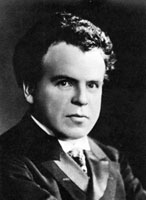
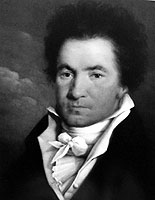 Lookalikes: Lamond (left) and Beethoven (right) |
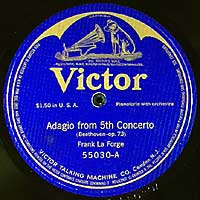 His 1927 "Appassionata," for example, sounds "lumpy" to modern ears but his slight agogic tempo variations and dynamics underscore the musical logic without breaching the essential momentum. And the fleet propulsion of the first movement of his "Moonlight" is far more pensive than somnolent, as most modern conceptions tend to be.
His 1927 "Appassionata," for example, sounds "lumpy" to modern ears but his slight agogic tempo variations and dynamics underscore the musical logic without breaching the essential momentum. And the fleet propulsion of the first movement of his "Moonlight" is far more pensive than somnolent, as most modern conceptions tend to be.
More opportune for present purposes, Lamond's 1922 Emperor was not only its phonographic debut but also the first complete recording of any Beethoven piano concerto, and remained alone in the catalog until joined by the Kempff First (Polydor, 1925), Bowen/Chapple Fourth (Vocalion, 1925) and Murdoch/Harty Third (Columbia, 1926). (Frank La Forge, an American who studied under Leschetizky, had cut a wonderfully elegant Emperor Adagio for Victor in 1912 with an uncredited orchestra; it can be heard at the Library of Congress's National Jukebox. Presumably to accommodate a single 4:35 side, five bars (10-14) are cut from the orchestral introduction and the tempo is nearly half again as fast as normal, imparting a lovely and unaccustomed sense of nimbleness and seemingly in the spirit of Beethoven's full tempo marking of Adagio un poco mosso (or moto) – slightly quicker than slow.) 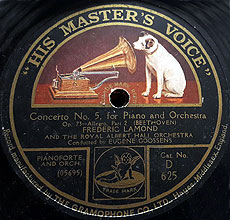 Lamond's conductor was Eugene Goossens, whose reputation as objective and polished is amply belied by his fleet and dynamic acoustical recordings of Petroushka, Scheherazade and several overtures. Yet the result is hardly as revolutionary as their reputations and separate recordings might suggest. Initially we must discount the sonic issues inherent in any acoustical recording – compressed dynamics (lest loud portions distort and softer ones sink below the noise floor), constricted overtones (resulting in the highest keyboard notes barely registering and blurring articulation so as to deprive rapid keyboard figures of much of their grace) and peculiar balances (in part from resonances of the horn and pickup mechanism, which here overstate the violins and flutes). That said, rather surprisingly the outwardly dramatic opening movement is largely straightforward, swiftly paced from the outset as Lamond barely grazes the whole-note trills in his three opening runs and seems utterly nonplussed by occasional sour notes in his rapid figurations. (Unlike his sonata recordings, here all ten sides required at least two takes, with third and fourth takes spilling over into a second session.) Yet Lamond subtly flexes the pacing during his solos, extends a few rests and slows to anticipate orchestral entrances. For his part, Goossens ensures interest with swift tempos and emphatic accenting. The often staid Adagio is uncommonly expressive, with lovingly shaped phrases, exquisitely smooth trills and natural rhythmic blending of sixteenth and triplet eighth note figures, while the rondo assumes an unusual degree of added character from tangible tension between the steady orchestra and some jagged, emphatic solo phrasing. Overall, the Lamond Emperor tends to present the cantabile side of Beethoven's own famed keyboard style and only hints at the extraordinary power he also was reputed to unleash.
Lamond's conductor was Eugene Goossens, whose reputation as objective and polished is amply belied by his fleet and dynamic acoustical recordings of Petroushka, Scheherazade and several overtures. Yet the result is hardly as revolutionary as their reputations and separate recordings might suggest. Initially we must discount the sonic issues inherent in any acoustical recording – compressed dynamics (lest loud portions distort and softer ones sink below the noise floor), constricted overtones (resulting in the highest keyboard notes barely registering and blurring articulation so as to deprive rapid keyboard figures of much of their grace) and peculiar balances (in part from resonances of the horn and pickup mechanism, which here overstate the violins and flutes). That said, rather surprisingly the outwardly dramatic opening movement is largely straightforward, swiftly paced from the outset as Lamond barely grazes the whole-note trills in his three opening runs and seems utterly nonplussed by occasional sour notes in his rapid figurations. (Unlike his sonata recordings, here all ten sides required at least two takes, with third and fourth takes spilling over into a second session.) Yet Lamond subtly flexes the pacing during his solos, extends a few rests and slows to anticipate orchestral entrances. For his part, Goossens ensures interest with swift tempos and emphatic accenting. The often staid Adagio is uncommonly expressive, with lovingly shaped phrases, exquisitely smooth trills and natural rhythmic blending of sixteenth and triplet eighth note figures, while the rondo assumes an unusual degree of added character from tangible tension between the steady orchestra and some jagged, emphatic solo phrasing. Overall, the Lamond Emperor tends to present the cantabile side of Beethoven's own famed keyboard style and only hints at the extraordinary power he also was reputed to unleash.
- Eugen d'Albert, Berlin Radio Orchestra, Bruno Seidler-Winkler (1930, Symposium CD)
A fascinating comparison is afforded by this broadcast recording (alas, only of the first movement, but preserved in remarkably fine fidelity). 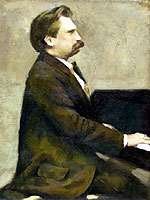 Also born in Glasgow, d'Albert was revered by Liszt as his foremost pupil, and came to be considered the foremost virtuoso of his time and a Beethoven specialist. Bruno Walter was awed with his Emperor: "I shall never forget the titanic force in his rendition. � He did not play it; he personified it." Allan Evans characterized his passagework as "large gestures of defiance and boldness. As phrase after phrase is hurled and delivered with the intent to stun, d'Albert creates a panorama of the concerto as having an outer cage, presented by the orchestra, which is home to beast, an elemental force. This shaping of the piano's role in relation to the orchestra alludes to the wildness surrounding the legend of Beethoven's persona and his own performance practice." Here, conductor Seidler-Winkler embarks on a rather broad overall tempo that underlines the score's power and enables d'Albert to milk some solos for intensive feeling and yet to take off impulsively with hair-raising propulsion and urgency. Although well beyond his glory days and out of practice (having long since turned to composing), amid the wrong notes and blurred runs d'Albert's hugely committed and impulsive playing is phenomenally thrilling with its overwhelmingly persuasive vitality, providing an essential complement to Lamond by conjuring the other, more forceful, side of Beethoven's own reputed performing style. (In 1906 D'Albert recorded a solo transcription of the complete Beethoven Fourth Concerto, including his own cadenzas, on four Hupfeld piano rolls that, despite suspicion of post-hoc alteration and enhancement, are heady and fascinating in their own right. D'Albert's Emperor and Fourth both can be heard on the forte-piano-pianissimo.com site.)
Also born in Glasgow, d'Albert was revered by Liszt as his foremost pupil, and came to be considered the foremost virtuoso of his time and a Beethoven specialist. Bruno Walter was awed with his Emperor: "I shall never forget the titanic force in his rendition. � He did not play it; he personified it." Allan Evans characterized his passagework as "large gestures of defiance and boldness. As phrase after phrase is hurled and delivered with the intent to stun, d'Albert creates a panorama of the concerto as having an outer cage, presented by the orchestra, which is home to beast, an elemental force. This shaping of the piano's role in relation to the orchestra alludes to the wildness surrounding the legend of Beethoven's persona and his own performance practice." Here, conductor Seidler-Winkler embarks on a rather broad overall tempo that underlines the score's power and enables d'Albert to milk some solos for intensive feeling and yet to take off impulsively with hair-raising propulsion and urgency. Although well beyond his glory days and out of practice (having long since turned to composing), amid the wrong notes and blurred runs d'Albert's hugely committed and impulsive playing is phenomenally thrilling with its overwhelmingly persuasive vitality, providing an essential complement to Lamond by conjuring the other, more forceful, side of Beethoven's own reputed performing style. (In 1906 D'Albert recorded a solo transcription of the complete Beethoven Fourth Concerto, including his own cadenzas, on four Hupfeld piano rolls that, despite suspicion of post-hoc alteration and enhancement, are heady and fascinating in their own right. D'Albert's Emperor and Fourth both can be heard on the forte-piano-pianissimo.com site.)
- Elly Ney, Berlin Philharmonic, Hermann Abendroth (1944, Tahra CD)
Born in 1882, Ney was nearly as close to Beethoven as Lamond and d'Albert, as she studied with Franz W�llner, a pupil of Anton Schindler,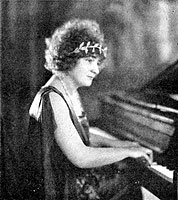
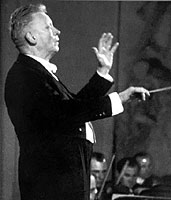 Beethoven's secretary. Yet, while Schindler's biography of Beethoven is filled with first-person insights, he has since been roundly discredited by scholars for exaggerating his own role and outright invention of claimed facts, and so perhaps his pedagogy is suspect as well. Even so, Ney was deeply devoted to Beethoven (even reading his Heiligenstadt Testament during recitals, and recording it) and was known as spontaneous, deeply spiritual and mystic (and, alas, as "the F�hrer's pianist," which doomed her post-War career to provincial concerts and teaching). Remarkably, we have two 1944 recordings of her Emperor just prior to her downfall. In a Vienna Philharmonic set (Urania) Karl Bohm leads a conventional, if rather stilted, accompaniment that perhaps inhibits her, with the result emerging as more labored than profound. (A 1960 Colosseum LP with the N�rnberg Symphony led by her former husband Willem van Hoogstraten finds her a pale ghost of her former grandeur.) Far more attuned is the Berlin Philharmonic under Abendroth, whose unfettered sense of autonomy provides an ideal setting for perhaps the most provocative, visceral and utterly spellbinding complete Emperor of all, from other-worldly clout as piano and orchestra trade explosive power-chords in the first movement to the percussiveness of thundering solo turns in the finale. While we will never know how Beethoven "heard" his Emperor, it seems hard to imagine a reading that transcends the actual sounds of his time any more than this, much less one that unleashes such unabashed, full-blooded emotion.
Beethoven's secretary. Yet, while Schindler's biography of Beethoven is filled with first-person insights, he has since been roundly discredited by scholars for exaggerating his own role and outright invention of claimed facts, and so perhaps his pedagogy is suspect as well. Even so, Ney was deeply devoted to Beethoven (even reading his Heiligenstadt Testament during recitals, and recording it) and was known as spontaneous, deeply spiritual and mystic (and, alas, as "the F�hrer's pianist," which doomed her post-War career to provincial concerts and teaching). Remarkably, we have two 1944 recordings of her Emperor just prior to her downfall. In a Vienna Philharmonic set (Urania) Karl Bohm leads a conventional, if rather stilted, accompaniment that perhaps inhibits her, with the result emerging as more labored than profound. (A 1960 Colosseum LP with the N�rnberg Symphony led by her former husband Willem van Hoogstraten finds her a pale ghost of her former grandeur.) Far more attuned is the Berlin Philharmonic under Abendroth, whose unfettered sense of autonomy provides an ideal setting for perhaps the most provocative, visceral and utterly spellbinding complete Emperor of all, from other-worldly clout as piano and orchestra trade explosive power-chords in the first movement to the percussiveness of thundering solo turns in the finale. While we will never know how Beethoven "heard" his Emperor, it seems hard to imagine a reading that transcends the actual sounds of his time any more than this, much less one that unleashes such unabashed, full-blooded emotion.
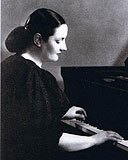
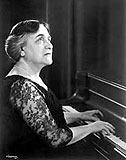
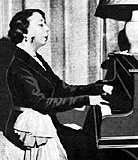 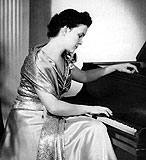
 Bachauer, Hess, Long, Karrer and Novaes (with dubious daughter) |
- Melvin Tan, London Classical Players, Roger Norrington (1990, EMI CD)
At this point,
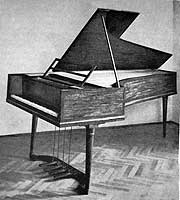 Beethoven's 1803 Erard piano |
![]() Of the hundred-plus other recordings of the Emperor, several (to me, among those I've heard) present a fascinating range of performing styles. As is my wont, I like to focus on the early ones, from an era before impersonality set in.
Of the hundred-plus other recordings of the Emperor, several (to me, among those I've heard) present a fascinating range of performing styles. As is my wont, I like to focus on the early ones, from an era before impersonality set in.
- Wilhelm Backhaus, Royal Albert Hall Orchestra, Landon Ronald (1927, Victor 78s, Biddulph CD)
They might not have had the pedigree of Lamond, d'Albert or Ney, but pianist Backhaus, conductor Ronald and his Royal Albert Hall orchestra all were veterans of the recording studio, each with over two decades of experience by the time they cut this second (and first electrical) Emperor.  Indeed, on July 15, 1909 Backhaus and Ronald (then conducting Beecham's recently-formed New Symphony Orchestra) had claimed the honor of the very first concerto ever recorded – the Grieg Piano Concerto, albeit radically pruned – the 12-minute opening movement and the 10-minute finale each was squeezed onto a single four-minute side and the lovely Adagio was omitted altogether. (Frank La Forge with the Victor Concert Orchestra under Walter P. Rogers would cut the Grieg Adagio in June, 1911; the fall Victor catalog falsely claimed it as "the first record of a piano with orchestral accompaniment.") While perhaps falling short of a critic's ecstatic enthusiasm ("bursts of eloquent magnificence which mere words fail to describe"), the Backhaus/Ronald Grieg disc is decently played, sensibly paced, well-recorded and gives a fair, if brief, impression of the work (and even includes a scrap of cadenza). Beyond all else, it opened producers' eyes to the feasibility of concerto recordings and paved the way to the abundance ever since which we can enjoy today. Speaking of which �
Indeed, on July 15, 1909 Backhaus and Ronald (then conducting Beecham's recently-formed New Symphony Orchestra) had claimed the honor of the very first concerto ever recorded – the Grieg Piano Concerto, albeit radically pruned – the 12-minute opening movement and the 10-minute finale each was squeezed onto a single four-minute side and the lovely Adagio was omitted altogether. (Frank La Forge with the Victor Concert Orchestra under Walter P. Rogers would cut the Grieg Adagio in June, 1911; the fall Victor catalog falsely claimed it as "the first record of a piano with orchestral accompaniment.") While perhaps falling short of a critic's ecstatic enthusiasm ("bursts of eloquent magnificence which mere words fail to describe"), the Backhaus/Ronald Grieg disc is decently played, sensibly paced, well-recorded and gives a fair, if brief, impression of the work (and even includes a scrap of cadenza). Beyond all else, it opened producers' eyes to the feasibility of concerto recordings and paved the way to the abundance ever since which we can enjoy today. Speaking of which �
With Backhaus we come to the next generation,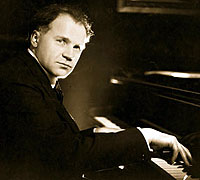 who were directly exposed to 19th century mannerisms yet were young enough to have recorded while still in their prime. In fact Backhaus studied with d'Albert but seems to have absorbed little of his mentor's outsized individuality in favor of calm modesty. As a result some critics came to consider him unduly dignified and even cold, yet it was that very naturalness and clarity that looked forward to the subtle demeanor prized in modern performance. Here Backhaus sticks closely to the score, presenting it with technical assurance and finesse – by no means dull, but never trying to second-guess what Beethoven actually wrote, adhering to sensible tempos and nicely balancing the heady and lyrical facets. While not ranked among the greatest conductors of his time, Ronald surely was one of the most influential, serving as producer, accompanist and ultimately "house conductor" for the Gramophone Company (HMV) throughout most of the acoustical era and in that role leading competent pioneering recordings that immeasurably popularized many essential works. Here he provides a rather solid and dutiful foil that complements Backhaus closely without adding inspiration of his own. Unfortunately, the orchestral opening of the Adagio oozes with gooey string portamenti (sliding between notes) and approximate intonation that spoils the mood for modern ears. Even so, the overall result presents the score with integrity while pointing the way beyond the outsized personalities of the 19th century masters toward our present temperament.
who were directly exposed to 19th century mannerisms yet were young enough to have recorded while still in their prime. In fact Backhaus studied with d'Albert but seems to have absorbed little of his mentor's outsized individuality in favor of calm modesty. As a result some critics came to consider him unduly dignified and even cold, yet it was that very naturalness and clarity that looked forward to the subtle demeanor prized in modern performance. Here Backhaus sticks closely to the score, presenting it with technical assurance and finesse – by no means dull, but never trying to second-guess what Beethoven actually wrote, adhering to sensible tempos and nicely balancing the heady and lyrical facets. While not ranked among the greatest conductors of his time, Ronald surely was one of the most influential, serving as producer, accompanist and ultimately "house conductor" for the Gramophone Company (HMV) throughout most of the acoustical era and in that role leading competent pioneering recordings that immeasurably popularized many essential works. Here he provides a rather solid and dutiful foil that complements Backhaus closely without adding inspiration of his own. Unfortunately, the orchestral opening of the Adagio oozes with gooey string portamenti (sliding between notes) and approximate intonation that spoils the mood for modern ears. Even so, the overall result presents the score with integrity while pointing the way beyond the outsized personalities of the 19th century masters toward our present temperament.
Backhaus would record the Emperor twice more for Decca with the Vienna Philharmonic (led by Clemens Krauss, 1953; and Hans Schmidt-Isserstedt, 1959). Although by then he was in his 'seventies, his readings are strikingly similar, albeit slower, with a somewhat greater degree of tempo variation and especially limpid Adagios. The orchestral contributions are more authoritative and, of course, the fidelity is improved and, ultimately, in stereo.
MIA All ten sides of the Backhaus/Ronald Emperor were cut on January 1, 1927.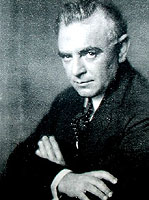 According to the Centre for the History and Analysis of Recorded Music database, on March 27 Columbia recorded it with Ignaz Friedman and the New Queen's Hall Orchestra led by Henry Wood but it never was issued. (Remarkably, a mere four days later Wood and the same orchestra cut the Beethoven Violin Concerto with Albert Sammons, but that set never was issued either.) What a dazzling Emperor it would have been! Schonberg describes Friedman's style as "completely his own, marked by a combination of incredible technique, musical freedom (some called it eccentricity), a tone that simply soared, and a naturally big approach, with dynamic extremes � – a true child of the late romantic age [whose] rhythms, accents and volcanic approach are apt to unsettle conservative listeners." Among Friedman's recorded legacy are two slices of Beethoven – while a dreamy but disappointingly conventional 1926 "Moonlight" Sonata comes alive only in the finale, a far more intriguing 1930 "Kreutzer" Sonata with Bronislaw Huberman brims with brazen assertiveness. We have but a single Friedman concerto recording – the Grieg, captured live (and how!) in a 1928 concert with Phillipe Gaubert leading an unidentified but presumably French orchestra that Friedman leaves in the dust. Phenomenally spirited and deeply personal, his solos are charged with startling improvisational and deeply personal vitality that more than hints at the power he must have unleashed in the Emperor. Perhaps someday a test pressing will surface. Until then we can only imagine its splendor.
According to the Centre for the History and Analysis of Recorded Music database, on March 27 Columbia recorded it with Ignaz Friedman and the New Queen's Hall Orchestra led by Henry Wood but it never was issued. (Remarkably, a mere four days later Wood and the same orchestra cut the Beethoven Violin Concerto with Albert Sammons, but that set never was issued either.) What a dazzling Emperor it would have been! Schonberg describes Friedman's style as "completely his own, marked by a combination of incredible technique, musical freedom (some called it eccentricity), a tone that simply soared, and a naturally big approach, with dynamic extremes � – a true child of the late romantic age [whose] rhythms, accents and volcanic approach are apt to unsettle conservative listeners." Among Friedman's recorded legacy are two slices of Beethoven – while a dreamy but disappointingly conventional 1926 "Moonlight" Sonata comes alive only in the finale, a far more intriguing 1930 "Kreutzer" Sonata with Bronislaw Huberman brims with brazen assertiveness. We have but a single Friedman concerto recording – the Grieg, captured live (and how!) in a 1928 concert with Phillipe Gaubert leading an unidentified but presumably French orchestra that Friedman leaves in the dust. Phenomenally spirited and deeply personal, his solos are charged with startling improvisational and deeply personal vitality that more than hints at the power he must have unleashed in the Emperor. Perhaps someday a test pressing will surface. Until then we can only imagine its splendor.
- Artur Schnabel, London Symphony Orchestra, Malcolm Sargent (1932, HMV 78s)
More than any other pianist of his time, Schnabel became identified with the interpretation of Beethoven's piano music,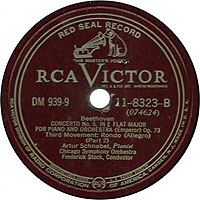
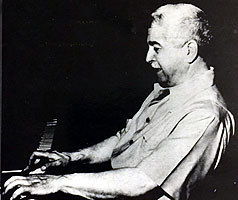 and not just because he pioneered concert cycles of all 32 sonatas and published a thoroughly-researched edition replete with his personal phrasing, fingering, tempos and what some consider excessive pedaling (although recall Czerny's claim that Beethoven actually used the sustaining pedal far more than he notated in his scores). Schnabel also produced the very first complete set of Beethoven sonata recordings, a venture deemed so risky at the time that it was undertaken as a limited edition of prepaid subscriptions. Since then it has transcended its historical importance to serve as a landmark of triumphant artistry, and has remained constantly in print, from public 78 editions through LPs, CDs and now downloads.
and not just because he pioneered concert cycles of all 32 sonatas and published a thoroughly-researched edition replete with his personal phrasing, fingering, tempos and what some consider excessive pedaling (although recall Czerny's claim that Beethoven actually used the sustaining pedal far more than he notated in his scores). Schnabel also produced the very first complete set of Beethoven sonata recordings, a venture deemed so risky at the time that it was undertaken as a limited edition of prepaid subscriptions. Since then it has transcended its historical importance to serve as a landmark of triumphant artistry, and has remained constantly in print, from public 78 editions through LPs, CDs and now downloads.
Although Schnabel was hailed as an intellectual, his playing is far from a dry or academic exercise; rather, he outlines the structures with vigor and vitality, conveying the architecture while eschewing the propensity of earlier Beethoven specialists to dwell on details. (Yet Schnabel humbly asserted that masterworks were better than anyone could ever perform, and magnanimously offered that although his predecessors' styles differed, Beethoven embraced them all.) Part of the first complete cycle of the Beethoven piano concertos (which included the very first recording of the Second), this 1932 Emperor reflects both Schnabel's self-effacement and his other love of (ironically, avant-garde) composing by conceiving the concerto as an integral whole, with piano and orchestra emerging as partners rather than rivals to keep the spotlight firmly focused on Beethoven rather than the interpreters' egos (alas, until the very end, when Sargent inexplicably breaks rank by yanking the final few bars).
Although he did not live to the stereo era Schnabel, too, rerecorded the Emperor twice – in 1942 with the Chicago Symphony under Frederick Stock for RCA and in 1947 with the Philharmonia under Alceo Galliera for HMV. While his approach remains essentially intact, the former has wider dynamics, brighter acoustics and gives a lesser sense of being fully integrated, while the latter upholds Galliera's reputation as a proficient and compliant accompanist.
- Walter Gieseking, Berlin Reichsender Orchestra, Arthur Rother (1944, Music and Arts CD; Pristine download)
Above all else Gieseking was celebrated for his extraordinary ability as a colorist. 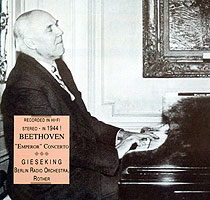
 In the late '30s his exquisite expressive touch produced astounding Debussy and Ravel recordings with piquant textures (his more prevalent post-War remakes are crude by comparison) as well as some Beethoven and a full set of Mozart solo piano pieces that may seem rather mild and undernourished nowadays but serve to present familiar pieces in an unaccustomed light by focusing on subtleties that others tend to overlook. Although the 1930s Vienna Philharmonic could sound scrappy as its ranks became decimated, they provide a rich, smooth complement for Gieseking's delicate pianism in a 1934 Columbia recording under Bruno Walter, long before his lapse into the autumnal contentment with which he closed out his career and by which most have come to know him. Admittedly, Gieseking's sensitivity dampens the score's muscularity, but substitutes a realm of warmth that is convincing in its own right. Gieseking remade the Emperor in 1951 and 1955 EMI studio versions with the Philharmonia led, respectively, by Karajan and Galliera. Both retain much, but not all, of the earlier magic, allied with more assertive orchestral backing. (Companion recordings of the Fourth are especially valuable, as Gieseking plays Beethoven's rarely-heard alternative cadenza, albeit with suppressed dynamics to best display his talent.)
In the late '30s his exquisite expressive touch produced astounding Debussy and Ravel recordings with piquant textures (his more prevalent post-War remakes are crude by comparison) as well as some Beethoven and a full set of Mozart solo piano pieces that may seem rather mild and undernourished nowadays but serve to present familiar pieces in an unaccustomed light by focusing on subtleties that others tend to overlook. Although the 1930s Vienna Philharmonic could sound scrappy as its ranks became decimated, they provide a rich, smooth complement for Gieseking's delicate pianism in a 1934 Columbia recording under Bruno Walter, long before his lapse into the autumnal contentment with which he closed out his career and by which most have come to know him. Admittedly, Gieseking's sensitivity dampens the score's muscularity, but substitutes a realm of warmth that is convincing in its own right. Gieseking remade the Emperor in 1951 and 1955 EMI studio versions with the Philharmonia led, respectively, by Karajan and Galliera. Both retain much, but not all, of the earlier magic, allied with more assertive orchestral backing. (Companion recordings of the Fourth are especially valuable, as Gieseking plays Beethoven's rarely-heard alternative cadenza, albeit with suppressed dynamics to best display his talent.)
But far more notable is his 1944 Berlin concert with Rother. Among the extremely few bounties to emerge from Nazi Germany was recording on wire, paper and ultimately tape, all developed a decade before the technology of embedding a stereo signal within a vinyl groove. The performance here not only finds Gieseking in fine form and with compelling accompaniment by an obscure yet remarkably proficient orchestra and conductor but is one of the very few made during the War to survive in genuine stereo, although the soundstage is not that of "fifth-row center" to which we are accustomed, but rather akin to the atmospheric fakery of 'sixties reissues that splayed the frequencies and overtones spatially without regard to their source. (Curiously, an earlier 1944 stereo recording of the finale of the Bruckner Eighth by Karajan and the Hessian Staatskapelle presents a somewhat more realistic spatial image.) Fascinating on a more perverse level is an unmistakable sound that intrudes during the soft beginning of the "non-cadenza" at the 17-minute mark of the first movement – artillery fire! Commentators have marveled at the musicians' concentration to continue unfazed in the midst of this most appallingly un-esthetic background and point out the irony that Beethoven had created the work during (and perhaps in defiance of) Napoleon's bombardment of Vienna.
- Wilhelm Kempff, Berlin Philharmonic, Peter Raabe (1936, Polydor)
This recording served (for me, at least) to question the extent to which the Emperor requires intensive interpretive input by a conductor. That's not to suggest that the orchestral portion isn't essential, nor to minimize the role of a conductor in coordinating and balancing the ensemble, but rather to recognize that the pianist presumably sets the pace, mood and texture. 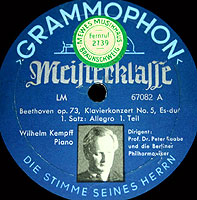
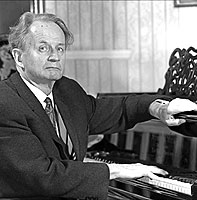 Given the historical insignificance of conductors and the pick-up nature of orchestras until the mid-19th century, plus the dearth of rehearsal available in Beethoven's time – not to mention that Beethoven's fame was built primarily upon his status as a piano virtuoso – it's hardly surprising should the Emperor to have been conceived to revolve around the soloist. Indeed, as already noted, the multiple Backhaus, Schnabel and Gieseking recordings display relatively minor differences among a variety of conductors. Kempff's three studio recordings, though, tell a far different story.
Given the historical insignificance of conductors and the pick-up nature of orchestras until the mid-19th century, plus the dearth of rehearsal available in Beethoven's time – not to mention that Beethoven's fame was built primarily upon his status as a piano virtuoso – it's hardly surprising should the Emperor to have been conceived to revolve around the soloist. Indeed, as already noted, the multiple Backhaus, Schnabel and Gieseking recordings display relatively minor differences among a variety of conductors. Kempff's three studio recordings, though, tell a far different story.
Raabe was famed as a Liszt expert and this appears to have been his only recording. Since he was in charge of all music under the Third Reich from 1935 until his death one month before that of his regime it's tempting to assume that this one time he might have seized the baton more by virtue of his authority than aptitude. And yet, the recorded result is quite respectable. Of course, it helped to have a superbly-trained orchestra that probably could have played the Emperor in its sleep. Yet in Kempff's subsequent remakes with the same orchestra under Paul Kempen (1953, DG) and Ferdinand Leitner (1963, DG) tempo variations and the force of the tuttis become progressively less pronounced, even though the overall timings remain fairly consistent. That, in turn, raises a question as to whether Kempff deferred to each conductor's prerogatives (and especially Raabe, with whom friction could have been treason) or rather, as his career advanced and his outlook aged, he simply mellowed and the conductors followed his lead. In any event, despite their disparity, in all three his solos avoid lapsing into sentimentality or, on the other hand, the type of egotistical displays that one might expect from Kempff playing his own cadenzas in the other Beethoven concertos (but not here, of course).
- Glenn Gould, American Symphony Orchestra, Leopold Stokowski (1966, Columbia LP; Sony CD)
In his highly opinionated writings, Gould eviscerated this work as "the supreme historical example of a composer on an ego trip," with an absence of harmonic and rhythmic variety and contrapuntal invention – "nowhere this side of the Grand Ole Opry can one encounter more unadorned II-V-I progressions" – and oppressed by "empty, banal, belligerent gestures that serve as his themes." And yet, Gould programmed Beethoven concertos in 2/3 of his 153 orchestral concerts, including 16 Emperors. In extensive session notes, Gould claimed that he aimed to "make this piece into a symphony with piano obbligato," to "demythologize the virtuoso traditions which have gathered round this particular work" and specifically to "sabotage the intrusions of solo exhibitionism upon concerto architecture" and "give short shrift to the competitive absurdities of the form" by "undercutting the you-play-your-theme-then-watch-me-do-it-slower-softer-subtler-than-you-can dichotomy which characterizes the conventional relationship between soloist and tutti force, between heroic individual and subservient mass." Gould's inflated rhetoric aside, Stokowski apparently agreed. While most critics seem to hear the result of their sole collaboration as an under-rehearsed battle, and although it begins with some of the most jagged (and thus defiantly attention-grabbing) opening arpeggios on record, the solos soon settle down to be willingly submerged within a lush, stately, symphonic texture that fits well into the traditional Stokowski "sound," here produced by the orchestra he founded and molded to his aural image. A fascinating comparison is Gould's last concerto performance, a 1970 TV broadcast with the Toronto Symphony under Karel Ancerl (Sony CD), when he suddenly was called in to substitute after Michelangeli cancelled. While the opening is just as overblown, the rest proceeds more conventionally at an overall 36�-minute pace (vs. Stokowski's 42�) with leaner textures and a more prominent balance for the solos (although the overall impression is partly due to the mid-fi mono sound, perhaps compounded under the circumstances by an absence of time to rehearse). A curious side-note: in a nod to pop technique, Gould proposed a radical approach to addressing his concerns over integrating the concerto forces by isolating them altogether – an unrealized experiment in which he and the orchestra would record their parts separately and only synchronize them in the studio.
"nowhere this side of the Grand Ole Opry can one encounter more unadorned II-V-I progressions" – and oppressed by "empty, banal, belligerent gestures that serve as his themes." And yet, Gould programmed Beethoven concertos in 2/3 of his 153 orchestral concerts, including 16 Emperors. In extensive session notes, Gould claimed that he aimed to "make this piece into a symphony with piano obbligato," to "demythologize the virtuoso traditions which have gathered round this particular work" and specifically to "sabotage the intrusions of solo exhibitionism upon concerto architecture" and "give short shrift to the competitive absurdities of the form" by "undercutting the you-play-your-theme-then-watch-me-do-it-slower-softer-subtler-than-you-can dichotomy which characterizes the conventional relationship between soloist and tutti force, between heroic individual and subservient mass." Gould's inflated rhetoric aside, Stokowski apparently agreed. While most critics seem to hear the result of their sole collaboration as an under-rehearsed battle, and although it begins with some of the most jagged (and thus defiantly attention-grabbing) opening arpeggios on record, the solos soon settle down to be willingly submerged within a lush, stately, symphonic texture that fits well into the traditional Stokowski "sound," here produced by the orchestra he founded and molded to his aural image. A fascinating comparison is Gould's last concerto performance, a 1970 TV broadcast with the Toronto Symphony under Karel Ancerl (Sony CD), when he suddenly was called in to substitute after Michelangeli cancelled. While the opening is just as overblown, the rest proceeds more conventionally at an overall 36�-minute pace (vs. Stokowski's 42�) with leaner textures and a more prominent balance for the solos (although the overall impression is partly due to the mid-fi mono sound, perhaps compounded under the circumstances by an absence of time to rehearse). A curious side-note: in a nod to pop technique, Gould proposed a radical approach to addressing his concerns over integrating the concerto forces by isolating them altogether – an unrealized experiment in which he and the orchestra would record their parts separately and only synchronize them in the studio.
- Edwin Fischer, Philharmonia, Wilhelm Furtw�ngler (1951, EMI)
As Schnabel was cutting the first full set of the Beethoven sonatas, Fischer secured his own place in phonographic history with his complete Bach Well-Tempered Clavier, which remains highly influential not only for having been the very first integral set of that cornerstone of the keyboard repertoire but for its deeply personal and intensely colored approach that paved the way for Gould and others to embrace Bach on their own individual terms. For Fischer's Emperor Furtw�ngler proved an ideal psychological match, as they both viewed their task as filling a composer's vessels with inspiration and spiritual energy. They began playing together in 1924 (the program included a Furtw�ngler-led Rite of Spring – that really must have been something!) and Furtw�ngler dedicated his massive 1937 Symphonic Concerto for Piano and Orchestra to Fischer, with whom he gave the world premiere. Paul Minchin suggests a further ground for their compatibility – Fischer was an acclaimed conductor, and Furtw�ngler a pianist. Amid the extreme variety of critical perspectives, their Emperor is universally acclaimed. Minchin calls it "the 'emperor' among all recorded versions" for its sheer grandeur, but it's far from aloof; rather, its most striking feature is the extraordinary understanding between solo and orchestra in which phrases, dynamics and tempos are molded with exceptional care to convey a deeply unified vision. While most of Furtw�ngler's studio recordings are stilted shadows of the splendors of his recorded concerts, this one breathes freely with imposing vitality as piano and orchestra blend into a single thriving organism. It rightly remains one of the most celebrated collaborations of soloist and conductor on record. (Here, too, we have a basis for comparison that serves to confirm the splendor of the 1951 alliance – a 1939 Electrola Emperor in which Fischer manages a roughly similar solo reading, yet the recorded balance tips solidly toward him while Karl Bohm and the Dresden Staatskapelle provide dutiful if somewhat crude accompaniment with barely a shred of the simpatico empathy generated by Furtw�ngler.)
which remains highly influential not only for having been the very first integral set of that cornerstone of the keyboard repertoire but for its deeply personal and intensely colored approach that paved the way for Gould and others to embrace Bach on their own individual terms. For Fischer's Emperor Furtw�ngler proved an ideal psychological match, as they both viewed their task as filling a composer's vessels with inspiration and spiritual energy. They began playing together in 1924 (the program included a Furtw�ngler-led Rite of Spring – that really must have been something!) and Furtw�ngler dedicated his massive 1937 Symphonic Concerto for Piano and Orchestra to Fischer, with whom he gave the world premiere. Paul Minchin suggests a further ground for their compatibility – Fischer was an acclaimed conductor, and Furtw�ngler a pianist. Amid the extreme variety of critical perspectives, their Emperor is universally acclaimed. Minchin calls it "the 'emperor' among all recorded versions" for its sheer grandeur, but it's far from aloof; rather, its most striking feature is the extraordinary understanding between solo and orchestra in which phrases, dynamics and tempos are molded with exceptional care to convey a deeply unified vision. While most of Furtw�ngler's studio recordings are stilted shadows of the splendors of his recorded concerts, this one breathes freely with imposing vitality as piano and orchestra blend into a single thriving organism. It rightly remains one of the most celebrated collaborations of soloist and conductor on record. (Here, too, we have a basis for comparison that serves to confirm the splendor of the 1951 alliance – a 1939 Electrola Emperor in which Fischer manages a roughly similar solo reading, yet the recorded balance tips solidly toward him while Karl Bohm and the Dresden Staatskapelle provide dutiful if somewhat crude accompaniment with barely a shred of the simpatico empathy generated by Furtw�ngler.)
![]() Several other Emperor recordings afford a fascinating opportunity to explore the interplay and relative influence of pianists and conductors, especially where their temperaments (at least according to reputation) seem to be particularly either matched or contrary. Here are some combinations that I've found especially intriguing:
Several other Emperor recordings afford a fascinating opportunity to explore the interplay and relative influence of pianists and conductors, especially where their temperaments (at least according to reputation) seem to be particularly either matched or contrary. Here are some combinations that I've found especially intriguing:
- Vladimir Horowitz,
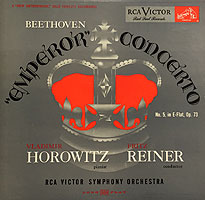 RCA Victor Symphony Orchestra, Fritz Reiner (1951, RCA Victor) – Both Horowitz and Reiner were known for their technical brilliance in the service of sharp, efficient precision. Yet their other, separate recordings display a wide range of temperament. Horowitz never hesitated to crank up the heat in more Romantic repertoire, as is amply evident from his famous 1930 Rachmaninoff Third with Albert Coates or the visceral coiled tension of his driven Tchaikovsky Firsts with Toscanini in 1941 (studio) or 1943 (concert). Nor was Reiner hesitant to accommodate the different approaches of soloists, as in the far less focused and austere Emperor he cut in 1961 with his Chicago Symphony and Van Cliburn, contrasted to his razor-sharp 1957 Tchaikovsky Violin Concerto with fellow-precisionist Jascha Heifetz. Here, in one of their only two recordings together, their underlying reputations melded as they render a clean, classical reading of lean, direct clarity and inexorable flow that scores its points without intrusion of performers' personalities. (Their other collaboration was a 1951 Rachmaninoff Third that's brilliant, if slightly glib compared to Horowitz's justly celebrated 1930 venture with Coates.)
RCA Victor Symphony Orchestra, Fritz Reiner (1951, RCA Victor) – Both Horowitz and Reiner were known for their technical brilliance in the service of sharp, efficient precision. Yet their other, separate recordings display a wide range of temperament. Horowitz never hesitated to crank up the heat in more Romantic repertoire, as is amply evident from his famous 1930 Rachmaninoff Third with Albert Coates or the visceral coiled tension of his driven Tchaikovsky Firsts with Toscanini in 1941 (studio) or 1943 (concert). Nor was Reiner hesitant to accommodate the different approaches of soloists, as in the far less focused and austere Emperor he cut in 1961 with his Chicago Symphony and Van Cliburn, contrasted to his razor-sharp 1957 Tchaikovsky Violin Concerto with fellow-precisionist Jascha Heifetz. Here, in one of their only two recordings together, their underlying reputations melded as they render a clean, classical reading of lean, direct clarity and inexorable flow that scores its points without intrusion of performers' personalities. (Their other collaboration was a 1951 Rachmaninoff Third that's brilliant, if slightly glib compared to Horowitz's justly celebrated 1930 venture with Coates.) - Arthur Rubinstein, London Philharmonic Orchestra, Daniel Barenboim (RCA, 1975) – At the opposite end of the interpretive spectrum, Rubinstein had recorded the Beethoven concertos with Joseph Krips and the Symphony of the Air in 1956 and with Erich Leinsdorf and the Boston Symphony in 1965, but for this final, autumnal recording of the Emperor Barenboim crafts a deeply empathetic setting that arises from a special bond, both professional and personal. Rubinstein not only launched and nurtured Barenboim's solo career but then encouraged his prot�g� to become a conductor and even provided his home for Barenboim's honeymoon with Jacqueline du Pr�. Here the 88-year old master, still in full command of his phenomenal technique, willingly trades emphasis and dynamism for a rich, contemplative final embrace of the Emperor, radiating an innate warmth that his 33-year old prodigy joyously supports.
- Daniel Barenboim, Philharmonia Orchestra, Otto Klemperer (EMI, 1968) – In this fascinating comparison,
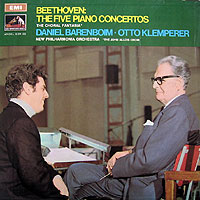
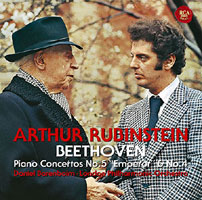 Barenboim, then 24 years old, switches hats to play the solo role for an 82-year old conductor well set in his ways. His timings are as broad as with Rubinstein, but the tone is vastly different, fully reflecting Klemperer's granitic, monolithic, solemn view, which Barenboim only barely tries to temper with occasional gestures of supple benevolence during his solo passages. Perhaps out of youthful respect, here the soloist clearly bowed to the glacial prerogatives of the esteemed elder conductor. I recognize that the British, in particular, tend to worship the authority and integrity of Klemperer's late recordings, but to me, at least, the end result here has neither breath nor heart.
Barenboim, then 24 years old, switches hats to play the solo role for an 82-year old conductor well set in his ways. His timings are as broad as with Rubinstein, but the tone is vastly different, fully reflecting Klemperer's granitic, monolithic, solemn view, which Barenboim only barely tries to temper with occasional gestures of supple benevolence during his solo passages. Perhaps out of youthful respect, here the soloist clearly bowed to the glacial prerogatives of the esteemed elder conductor. I recognize that the British, in particular, tend to worship the authority and integrity of Klemperer's late recordings, but to me, at least, the end result here has neither breath nor heart. - Benno Moiseiwitsch, London Philharmonic, George Szell (1938, HMV) – At first glance, based entirely upon reputation, this combination would suggest friction between an elegant, sensitive, tasteful player and a strict, literal, detached conductor. Yet even if such descriptions might suitably describe their styles toward the end of their careers (i.e., Moiseiwitsch's dignified yet lyrical 1955 Rachmaninoff Concerto # 2 with Hugo Rignold leading the Philharmonia; Szell's rather dry and crisp 1961 Emperor with Leon Fleischer), their styles were far different in earlier times. Thus Moiseiwitsch produced a deeply dramatic Moussorgsky Pictures at an Exhibition in 1945 and easily kept pace with Heifetz in a fiery 1951 Beethoven "Kreutzer" Sonata, while Szell enthusiastically wrapped himself around the heartfelt passion of Pablo Casals in their 1937 recording of the Dvorak Cello Concerto with the Czech Philharmonic. Here, both are wondrously poetic, giving due regard to the emotional ebb and flow of the Emperor – less a departure from their late personal styles than an essential reminder that artists do evolve over time and that our memories of their art naturally, if regrettably, are formed by more recent impressions at the expense of a richer past history.
- Rudolph Serkin, New York Philharmonic, Bruno Walter (1941, Columbia) – The back cover of Serkin's 1962 New York Philharmonic remake with Leonard Bernstein (Columbia MS 6366) displays a dozen of his other LPs and proclaims them "thrilling recordings you'll enjoy." Uh, not really – enjoyable certainly, but Serkin was respected as athletic but sober, focused and controlled, rather than a pianist who generated conventional thrills. And yet, the first of Serkin's four (!) studio Emperors was captured during the brief window in Walter's career when, newly arrived in America, he generated atypically volcanic concerts, and here together they tear through the work with headstrong momentum (except, of course, for the respite of the Adagio) that truly is thrilling. In contrast, Serkin's second recording, with the Philadelphia Orchestra under Eugene Ormandy (1950, Columbia) proceeds with roughly similar overall tempos but considerably more inflection in the solo portions. In 1962 Serkin hews to a middle path, largely straight-forward, but closely supporting Bernstein's athletic vigor and rhythmic heft in shaping the orchestral portions. His final recording, with the Boston Symphony under Seiji Ozawa (1981, Teldec)
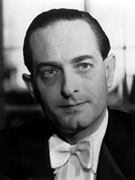
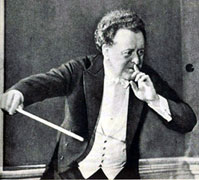 broadens considerably, dwelling on structural details and trading the visceral potency of his former versions for an inner strength tempered by tenderness uncommon in the Serkin canon (plus a vivid recording that necessarily focuses attention on the interplay of instrumental textures). Perhaps the takeaway here is that artistic integrity consists not necessarily of insistence upon a distinctive personal style under all circumstances but also in respecting and complementing the proclivities of one's colleagues.
broadens considerably, dwelling on structural details and trading the visceral potency of his former versions for an inner strength tempered by tenderness uncommon in the Serkin canon (plus a vivid recording that necessarily focuses attention on the interplay of instrumental textures). Perhaps the takeaway here is that artistic integrity consists not necessarily of insistence upon a distinctive personal style under all circumstances but also in respecting and complementing the proclivities of one's colleagues. - Cor de Groot, Concertgebouw Orchestra, Willem Mengelberg (1942 concert, APR CD) – While the vast majority of Emperors reflect primarily the vision and prerogatives of the soloist, or at least a co-equal partnership with the conductor, this startling concert documents the other extreme in which Mengelberg leads a wild roller-coaster ride through the first movement and finale. While he occasionally tends to rein it in to let the piano temporarily tame matters, the rest suggests a titanic, heaven-storming, existential struggle, fueled by insistent timpani, that borders on anger and loses all sense of continuity, much less mutuality, in the process.
Poor de Groot, known for his sensitivity, is simply swamped. (His 1951 studio Emperor with the Hague Philharmonic under Willem van Otterloo [Philips LP] is somewhat more inflected than usual but in a far milder league. The album cover, though, surely merits an award for absurdity, although its irrelevance does deflect glare from others' obsessive depiction of regal garb, crowns and such.) Mengelberg's other live wartime concerto recordings range from relatively chaste (Mozart 19 with Andriessen, Schumann with von Sauer) to characteristically dramatic (Liszt 2 with Flipse, Rachmaninoff 3 with Geiseking) yet none more than grazes the demonic energy he apparently felt in the Emperor. Faced with such intensity, de Groot could hardly resist capitulating.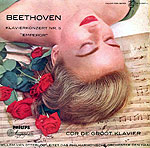
What were they thinking??
Although I personally consider them of lesser interest and significance 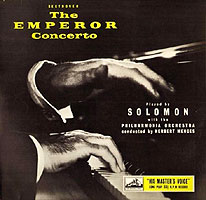 (and, having reached my limit, I'll leave the further stereo and digital recordings to others), I should briefly mention the other pre-stereo Emperors I've encountered: Matthews/Philharmonia/Susskind (1947, Columbia) – acute, detailed sound with emphatic orchestral accents; Curzon/London Philharmonic/Szell (Decca, 1949) – well-balanced, with Decca's vivid FFRR recording; Badura-Skoda/Vienna State Opera Orchestra/Scherchen (1951, Westminster) – wide-ranging solos, from potent to attenuated, from respective early advocates for authentic instruments and early music; Solomon/Philharmonia/Menges (1955, EMI) – lyrical and gentle if a bit undernourished; and Casadeus/NY Philharmonic/Mitropoulos (1956, Columbia) – surprisingly propulsive and heady in light of Casadesus's reputation for shallow elegance. All are skillful readings that afford a fine opportunity to get to know the Emperor and provide a solid foundation for exploration of the special insights presented by the ones on which we have dwelled.
(and, having reached my limit, I'll leave the further stereo and digital recordings to others), I should briefly mention the other pre-stereo Emperors I've encountered: Matthews/Philharmonia/Susskind (1947, Columbia) – acute, detailed sound with emphatic orchestral accents; Curzon/London Philharmonic/Szell (Decca, 1949) – well-balanced, with Decca's vivid FFRR recording; Badura-Skoda/Vienna State Opera Orchestra/Scherchen (1951, Westminster) – wide-ranging solos, from potent to attenuated, from respective early advocates for authentic instruments and early music; Solomon/Philharmonia/Menges (1955, EMI) – lyrical and gentle if a bit undernourished; and Casadeus/NY Philharmonic/Mitropoulos (1956, Columbia) – surprisingly propulsive and heady in light of Casadesus's reputation for shallow elegance. All are skillful readings that afford a fine opportunity to get to know the Emperor and provide a solid foundation for exploration of the special insights presented by the ones on which we have dwelled.
![]() Having done no original research (other than lots of listening) for this article, and while I'm prepared to accept blame for the musical judgments, I gratefully acknowledge the following sources for the facts and quotations:
Having done no original research (other than lots of listening) for this article, and while I'm prepared to accept blame for the musical judgments, I gratefully acknowledge the following sources for the facts and quotations:
- Abraham, Gerald: "Beethoven and the Symphonic Concerto" in The New Oxford History of Music (Oxford, 1982)
- Bagar, Robert and Louis Biancolli: The Concert Companion (Whittlesey House, 1947)
- Blom, Eric: notes to the Schnabel LP box of the Beethoven concertos (Angel GRE 4006, 1963)
- Burr, Charles: notes to the Casadeus/Mitropoulos Emperor LP (Columbia ML 5100, 1956)
- Cairnes, David: notes to the Arrau/Haitink Emperor LP (Philips 839 800, 1964)
- Caldicott, Anne-Louise: "Performance Practice in Beethoven's Day," in Barry Cooper, ed., Beethoven: A Compendium (Borders, 1991)
- Cook, Nicholas: on The Unheard Beethoven website
- Goddard, Scott: "Ludwig von Beethoven," article in Ralph Hill, ed., The Concerto (Penguin, 1952)
- Grunfeld, Fred: notes to the Gould/Bernstein Beethoven Third (Columbia MS 6096, 1959)
- Hall, David: notes to the Serkin/Walter Emperor LP (Columbia ML 4004)
- Hodgson, Antony: notes to the Blumenthal/Waldhans LP: Beethoven: Piano Concerto in E flat major (1784) (Unicorn UNS 208, 1970)
- Hoffmann-Erbrecht, Lothar: notes to the Arrau/Davis Emperor CD (Philips 416 251-1, 1984)
- Klaus, George Roy: notes to the Fleischer/Szell Emperor LP (Epic BC-1139, 1961)
- Kolodin, Irving: notes to the Schnabel/Stock Emperor LP (Victrola VIC-1511, 1970)
- Kolodin, Irving: notes to the Horowitz/Reiner Emperor LP (RCA LM 1718, 1951)
- Kramer, Jonathan: Listen to the Music (Schirmer, 1988)
- Mann, William: notes to the Barenboim/Klemperer Emperor CD (EMI 7 63360 2 (1989)
- Marek, George: Beethoven: Biography of a Genius (Funk and Wagnalls, 1969)
- Marston, Nocholas: notes to the Zimmermann/Bernstein Emperor CD (DG 429 748-2, 1989)
- Matthews, Denis: notes to the Fischer/Furtwangler Emperor LP (HMV ALP 1051)
- Meyer, John A.: "The Concerto," in Gerald Abraham, ed., The New Oxford History of Music: The Age of Beethoven, 1790-1830 (Oxford, 1982)
- Minchin, Paul: notes to the Fischer/Furtwangler Emperor LP (HMV HLM 7027, 1973)
- Nelson, Chris: notes to the Gould/Stokowski Emperor LP (Columbia MS 6888, 1966)
- Page, Tim (ed): The Glenn Gould Reader (Knopf, 1984)
- Porter, Andrew: notes to the Gilels/Ludwig Emperor LP (Angel S 35476, 1957)
- Schindler, Anton: Beethoven as I Knew Him; tr., Constance S. Jolly; ed., Donald W. MacArdle (Norton, 1972)
- Schonberg, Harold: The Great Pianists (Simon and Schuster, 1987)
- Solomon, Maynard: Beethoven (Schirmer, 1977)
- Steinberg, Michael: The Concerto: A Listener's Guide (Oxford, 1998)
- Summers, Jonathan: notes to the Lamond/Goossens Emperor CD (Biddulph LHW 042, 1998)
- Swafford, Jan: Beethoven: Anguish and Triumph (Houghton Mifflin, 2014)
- Thayer, Alexander Wheelock: Life of Beethoven, rev. and ed., Elliot Forbes (Princeton, 1967)
- Vicat, Alan: notes to The Pupils of Liszt CD (Pearl CDS 9972, 1992)
- Warrack, John: notes to the Gulda/Swarowsky Emperor LP (Concert Hall AM 2307, 1963)
- [unidentified author]: notes to the Galling/Bunte The Young Beethoven LP (Turnabout TV-S 34367, c. 1970)
Several editions of the Emperor score are available for free viewing and download from the fabulous Petrucci Music Library.
![]()
Copyright 2017 by Peter Gutmann
copyright © 1998–2017 by Peter Gutmann. All rights reserved.